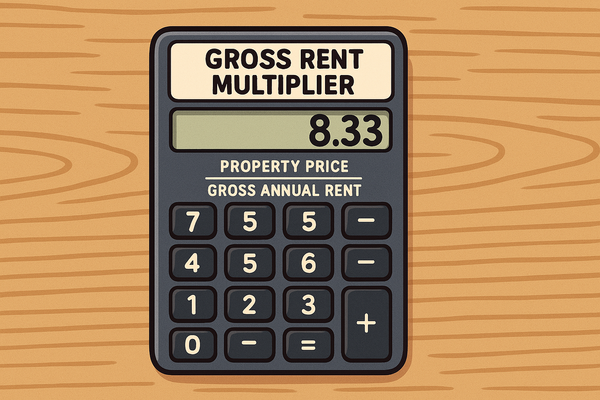Certificate of Occupancy: What Property Managers Must Know
Avoid $1,000 daily fines by understanding the essential requirements for your building's legal "permission slip"

Did you know that operating a property without a valid certificate of occupancy can result in fines of up to $1,000 per day in some jurisdictions? This critical document serves as your building's "permission slip" to be legally occupied, yet many property management professionals are unclear about when it's required or how to obtain one.
In this comprehensive guide, we'll explore everything property managers need to know about certificates of occupancy (COs). From understanding the application process to navigating common inspection challenges, you'll learn practical strategies to ensure your properties maintain proper compliance while avoiding costly delays and penalties.
Whether you're managing a newly constructed building, renovating an existing property, or changing a building's use, this article will provide you with the essential knowledge to navigate certificate of occupancy requirements with confidence.
Definition and Background
A certificate of occupancy is a legal document issued by a local government agency or building department that certifies a building's compliance with applicable building codes and confirms the structure is in suitable condition for safe occupancy. This official verification proves that the property meets all housing and building codes as determined by local authorities and is legally habitable based on its designated use and property type.
The document typically includes three key components:
- A description of the specific legal use and type of property (zoning classification)
- Verification that the property complies with all applicable codes
- Confirmation that the property is suitable for occupancy
In some cases, a temporary certificate of occupancy (TCO) may be issued. This grants the same rights as a standard CO but only for a limited timeframe, typically 90 days in jurisdictions like New York City. TCOs allow property owners to begin using completed portions of a building while final details are being completed on other areas.
The concept of certificates of occupancy has evolved alongside building safety regulations. What began as basic safety verifications has developed into comprehensive assessments covering everything from structural integrity to environmental standards. Today's COs represent the culmination of numerous inspections, ensuring buildings meet increasingly stringent safety and accessibility requirements before being inhabited.
It's important to note that requirements vary significantly by jurisdiction. While the fundamental purpose remains consistent—verifying safety and compliance—the specific process, documentation, and inspection requirements can differ dramatically from one locality to another.
This is a general overview of the application and submission process for certificates of occupancy:
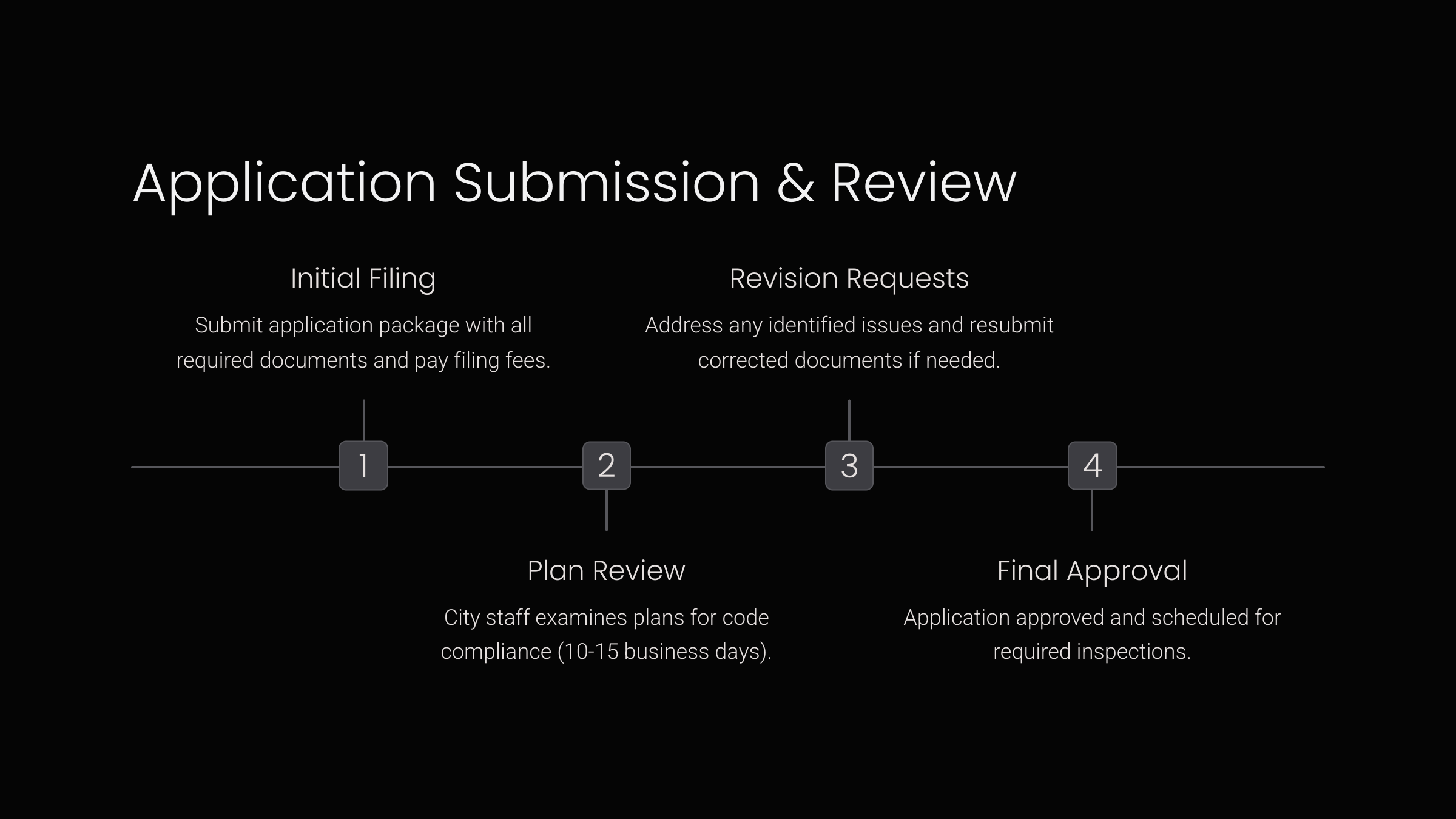
Significance in Property Management
Understanding certificates of occupancy is critical for property managers for several compelling reasons that directly impact day-to-day operations, legal compliance, and financial outcomes. For those considering whether to manage your own rental property or hire a property management company, understanding these compliance requirements is crucial to your decision.
Legal and Operational Impact
From a legal standpoint, a certificate of occupancy is required by law for any property intended for human habitation. Operating without a valid CO can expose property managers to significant liability. According to building department regulations across multiple jurisdictions, no one may legally occupy a structure until a CO or TCO is issued. This means property managers who allow occupancy without proper certification could face penalties ranging from monetary fines to cease and desist orders.
The operational significance extends beyond merely avoiding penalties. A CO serves as evidence that the building complies with approved plans and specifications, confirming occupants' safety before a building is used. For property managers, this translates to reduced liability risk and greater confidence in the building's structural integrity and systems functionality.
Financial Considerations
The financial implications of certificate of occupancy compliance are substantial. This documentation is necessary to sign contracts to sell property and close mortgages, making it essential for real estate transactions and property transfers. Without a valid CO, property managers may find themselves unable to complete financial transactions or secure financing for their properties.
Additionally, property valuation is directly impacted by CO status. Properties lacking proper certification typically face reduced market value and may be ineligible for certain insurance coverages, creating additional financial vulnerability for owners and managers.
In some jurisdictions, a valid CO is required for utility service connections and obtaining business licenses for rental properties. Without these essentials, property managers cannot provide basic services to tenants, potentially resulting in lost rental income and damaged tenant relationships.
Practical Applications
Understanding when and how to obtain a certificate of occupancy is essential for property managers in various real-world scenarios. These practical applications are particularly important for professionals working with apartment homes and multi-family properties, where tenant safety and regulatory compliance intersect. Let's explore common situations where COs come into play and the practical steps for navigating the process.
Scenario 1: New Construction Project
Situation: You're managing the completion of a newly constructed apartment building and need to ensure it can be legally occupied by tenants.
Application: A new certificate of occupancy is required for any newly constructed building before it can be legally occupied.
Steps to Address:
- Complete all construction according to approved plans
- Submit application to the local building department
- Schedule required inspections, which typically include:
- Fire safety systems
- Electrical wiring
- Plumbing systems
- Structural elements and exits
- Ensure authorized representatives are present during all inspections
- Pay required fees (which vary significantly by location)
- Address any issues identified during inspections
- Receive and post the certificate in a visible location within the building
Outcome: With a valid certificate of occupancy, you can legally begin tenant move-ins and avoid potential legal complications or delays in rental income.
Scenario 2: Change of Building Use
Situation: You're converting a former industrial building into residential lofts.
Application: When a building's use changes (e.g., from industrial to residential), a new certificate of occupancy is required to reflect the new occupancy classification.
Steps to Address:
- Verify zoning permits the new intended use
- Obtain necessary building permits for renovation
- Ensure renovations meet current building codes for residential occupancy
- Submit CO application with updated plans showing the new use
- Complete all required inspections specific to residential occupancy
- Address any code requirements unique to residential properties
- Obtain final approval from building officials
Outcome: The property now has legal documentation of its changed use, ensuring compliance with residential safety standards and allowing you to market and lease the units as residential spaces.
Scenario 3: Major Renovation of Existing Property
Situation: You're overseeing substantial renovations to a multi-family residential building.
Application: Major renovations, especially those involving reconfiguration of living spaces or affecting 4+ dwelling units, typically require an updated certificate of occupancy.
Steps to Address:
- Determine if the scope of renovation triggers CO requirements in your jurisdiction
- For substantial alterations, apply for building permits that indicate the need for an updated CO
- Ensure renovations comply with current building codes (not just codes in effect when the building was originally constructed)
- Schedule inspections at appropriate construction milestones
- Consider applying for a temporary certificate of occupancy if portions of the building will be completed and occupied before the entire project is finished
- Complete final inspections and address any outstanding issues
Outcome: The renovated property receives updated certification reflecting its improved condition and compliance with current safety standards, potentially increasing property value and marketability.
Legal and Compliance Considerations
Navigating the legal framework surrounding certificates of occupancy requires understanding the regulatory authorities, documentation requirements, and compliance considerations that vary across jurisdictions.
Regulatory Authority and Variations
Certificates of occupancy are issued by local government agencies or building departments, with requirements varying widely across different jurisdictions. While the core purpose remains consistent—ensuring safety and compliance—the specific regulations can differ significantly from one location to another.
Property managers must familiarize themselves with local building codes and zoning regulations that govern the CO process in their specific areas. For example, in Washington DC, single-family residences in zones R-1A, R-1B, R-2, and R-3 are exempt from certificate of occupancy requirements, while in other jurisdictions, all residential structures require certification.
These geographical variations extend to documentation requirements, inspection processes, and even the definition of what constitutes a "substantial" renovation requiring a new CO. Understanding these local nuances is critical for maintaining compliance across properties in different locations.
Documentation and Compliance Requirements
To obtain a certificate of occupancy, properties must confirm compliance with a comprehensive range of regulations, including:
- Local building codes
- Zoning regulations
- Fire safety standards
- Electrical, plumbing, and structural codes
- Environmental regulations in applicable cases
- Green Building Act standards (in jurisdictions like Washington DC)
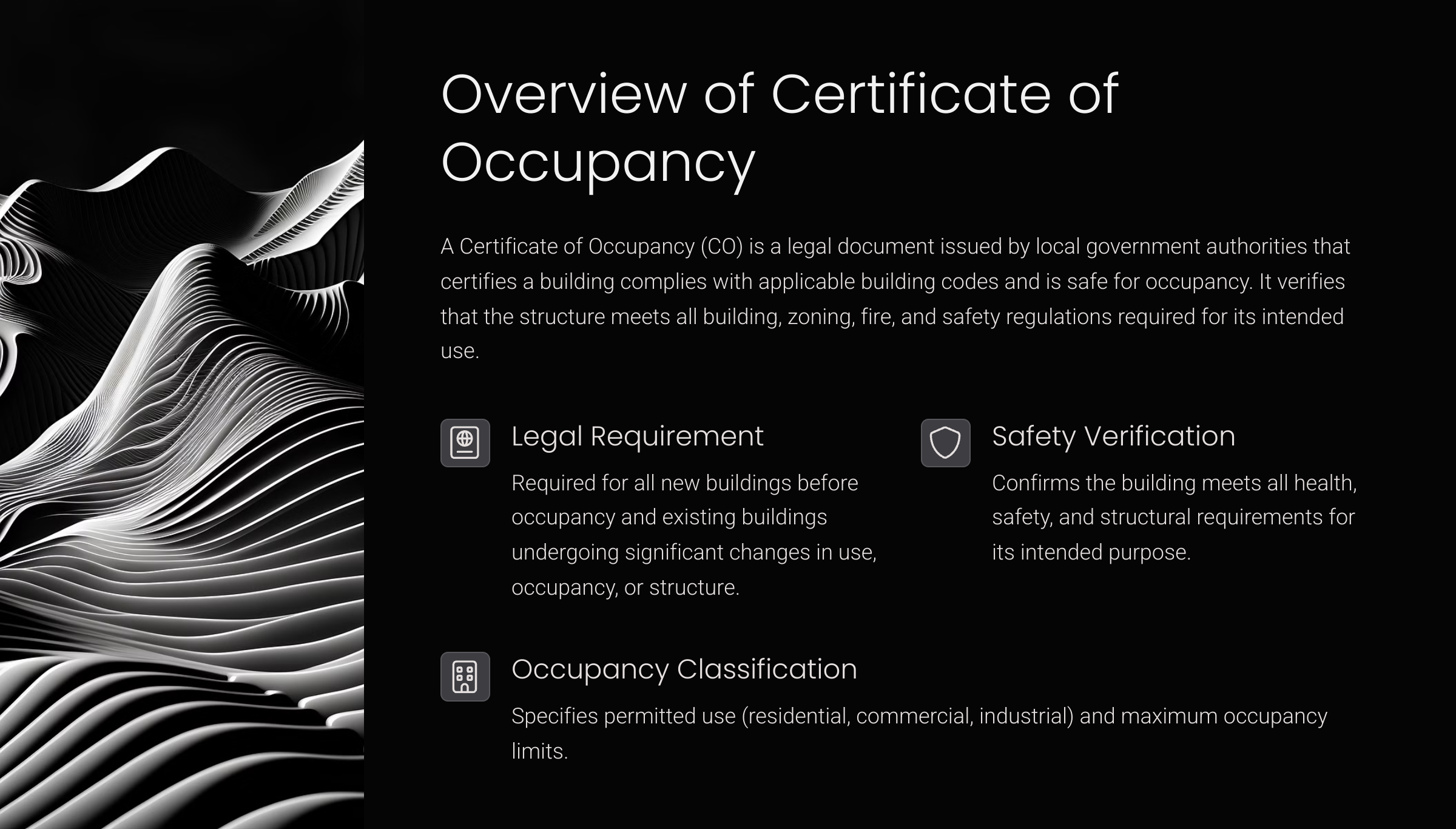
A CO confirms that all applicable laws are satisfied, all necessary paperwork has been completed, all fees have been paid, all violations have been resolved, and all required approvals from other agencies have been received.
It's worth noting that a certificate of occupancy typically has no expiration date in most jurisdictions, remaining valid until there is a change in use, occupancy, or substantial renovation. However, buildings existing before the adoption of current building codes may maintain their existing use or occupancy only if the use was legal at the time of code adoption. Any change in use or occupancy requires compliance with current codes, which can present significant challenges for older properties.
Consequences of Non-Compliance
Operating a property without a required certificate of occupancy can result in severe consequences:
- Financial penalties that increase with continued non-compliance
- Orders to vacate the premises, displacing tenants and disrupting income
- Potential denial of insurance claims if incidents occur in non-compliant spaces
- Personal liability for property managers who knowingly violate occupancy requirements
- Difficulties selling or refinancing the property
These consequences underscore the importance of proactive compliance with CO requirements as a fundamental aspect of responsible property management.
Best Practices
Implementing strategic approaches to certificate of occupancy management can help property managers navigate the process efficiently while minimizing delays and complications. Here are five actionable best practices based on industry expertise:
Research Local Requirements Thoroughly
Implementation Steps:
- Contact your local building or zoning inspection office before beginning any project requiring a CO
- Request written guidelines specific to your property type and jurisdiction
- Schedule a pre-application consultation with building officials to clarify requirements
- Create a checklist of required documentation specific to your locality
Local requirements vary significantly, and what applies in one jurisdiction may not apply in another. For example, Rochester, NY charges a $60 flat fee for single-family homes, while Tamarac, FL requires a $260 safety permit plus $89 and $3 per 1,000 square feet. Understanding these variations early prevents costly surprises later.
Maintain Comprehensive Documentation
Implementation Steps:
- Create digital and physical folders for all CO-related documents
- Retain copies of all permits, plans, inspection reports, and correspondence
- Document all interactions with building officials, including names, dates, and outcomes
- Photograph completed work prior to inspections
- Keep records of previous certificates for all properties
Complete documentation serves multiple purposes: facilitating the application process, providing evidence of compliance during inspections, and creating a historical record for future property transactions or renovations. Digital document management systems specifically designed for property management can streamline this process.
Prepare Meticulously for Inspections
Implementation Steps:
- Review inspection checklists provided by local authorities
- Conduct pre-inspections with qualified contractors to identify potential issues
- Ensure all systems are operational and accessible for inspection
- Prepare a list of any known issues with remediation plans
- Have authorized representatives present who can answer technical questions
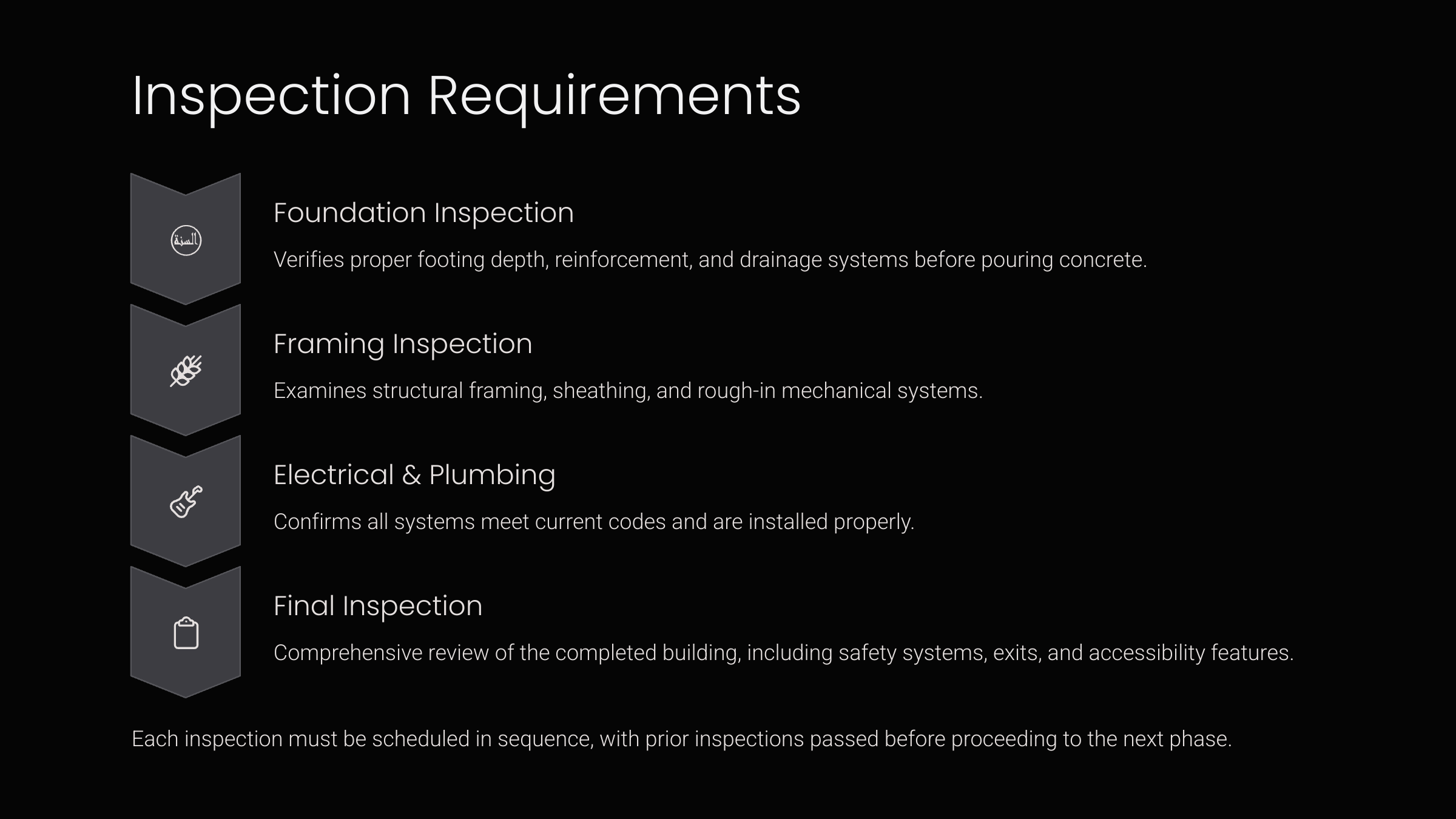
Failed inspections are among the most common causes of CO delays. By conducting thorough pre-inspections and addressing issues proactively, property managers can significantly increase first-time inspection pass rates, reducing project timelines and costs.
Develop Relationships with Building Officials
Implementation Steps:
- Attend local building department workshops or informational sessions
- Join local property management associations that interact with building departments
- Maintain professional, collaborative communication throughout the process
- Request clarification rather than challenging decisions when disagreements arise
- Follow up with thank-you notes after successful project completions
Building officials exercise considerable discretion in many aspects of the CO process. Developing professional relationships based on mutual respect and cooperation can facilitate smoother interactions and potentially expedite approvals when time is critical.
Consider Temporary Certificates for Phased Occupancy
Implementation Steps:
- Identify completed portions of projects that could qualify for temporary occupancy
- Understand local TCO requirements and limitations
- Develop clear plans for completing remaining work while occupied spaces are in use
- Budget for additional inspection fees associated with TCOs
- Create a tracking system for TCO expiration dates to ensure timely conversion to permanent COs
Temporary certificates of occupancy can significantly improve cash flow by allowing partial occupancy while completing final details. This approach is particularly valuable for large-scale developments or extensive renovations where different areas reach completion at different times.
Related Concepts
Understanding certificates of occupancy in the context of related property management concepts provides a more comprehensive grasp of the regulatory landscape. Here are key related terms that property managers should understand:
Building Permits
Building permits are required documentation before construction begins, indicating that proposed work will comply with applicable codes. Unlike certificates of occupancy, which authorize occupancy after construction, building permits authorize the construction itself. The relationship is sequential: first obtain the building permit, complete construction according to approved plans, then receive the certificate of occupancy.
Understanding both concepts is valuable because building permit specifications directly impact CO requirements. Any deviations from approved building permit plans may result in CO denial, making coordination between these processes essential for project success.
Occupancy Classifications
Occupancy classifications categorize buildings based on their intended use and associated safety requirements. These classifications (such as Residential Group R, Business Group B, or Assembly Group A) determine specific code requirements that must be met for CO approval.
Different occupancy types have varying requirements for elements like fire protection, egress, and accessibility. When a building changes from one occupancy classification to another (e.g., from business to residential), substantial modifications may be needed to meet the new classification's requirements before a CO can be issued.
Certified Occupancy Specialist (COS)
The Certified Occupancy Specialist is a professional certification for those managing HUD-regulated affordable housing. It's the most widely-sought certification in the HUD affordable housing industry, requiring completion of training on HUD guidelines in Handbook 4350.3 REV-1 and annual renewal with continuing education requirements (6 hours/year).
While not directly related to obtaining a certificate of occupancy, this certification demonstrates expertise in occupancy regulations for subsidized housing. Property managers working with affordable housing benefit from understanding both general CO requirements and the specific occupancy standards associated with HUD programs.
Beneficial Occupancy and Substantial Completion
Beneficial occupancy refers to when a property owner uses part of a property prior to full completion, while substantial completion indicates construction is sufficiently complete for intended use. These concepts often relate to temporary certificates of occupancy, which allow limited use while final details are completed.
Understanding these milestone definitions helps property managers coordinate move-ins, leasing activities, and vendor installations during the critical transition from construction to occupancy, optimizing the timeline while maintaining compliance.
Property managers should also be aware of the demographic amenity divide in relation to property improvements and renovations. Meeting tenant expectations while managing regulatory requirements like certificates of occupancy creates a challenging balance that successful property managers must navigate.
Common Questions
How much does a certificate of occupancy cost?
Fees for certificates of occupancy vary significantly by location and property type. For example, Rochester, NY charges a $60 flat fee for single-family homes, while Philadelphia, PA requires a $100 filing fee applied toward a $235 permit fee, plus city/state surcharges. Tamarac, FL's fee structure includes a $260 safety permit plus $89 and $3 per 1,000 square feet.
For accurate budgeting, contact your local building department early in the planning process to understand all applicable fees, including potential additional charges for re-inspections or expedited processing. Some jurisdictions also offer online fee calculators specific to your project type and size.
Are single-family homes exempt from certificate of occupancy requirements?
The exemption status for single-family homes depends entirely on your jurisdiction. In Washington DC, single-family residences in zones R-1A, R-1B, R-2, and R-3 are exempt from certificate of occupancy requirements. In this same jurisdiction, townhomes and condos are considered single-family homes for CO purposes.
However, many other jurisdictions require COs for all residential structures, regardless of size. Additionally, even in areas with exemptions for single-family homes, these exemptions typically don't apply to newly constructed homes, which still require initial certification.
What happens if my building fails inspection?
Failed inspections reveal code violations that must be corrected before a certificate of occupancy can be issued. The building department will provide documentation of specific deficiencies that need addressing. Timeframes for completing repairs are determined by municipal authorities and vary based on the severity of the issues.
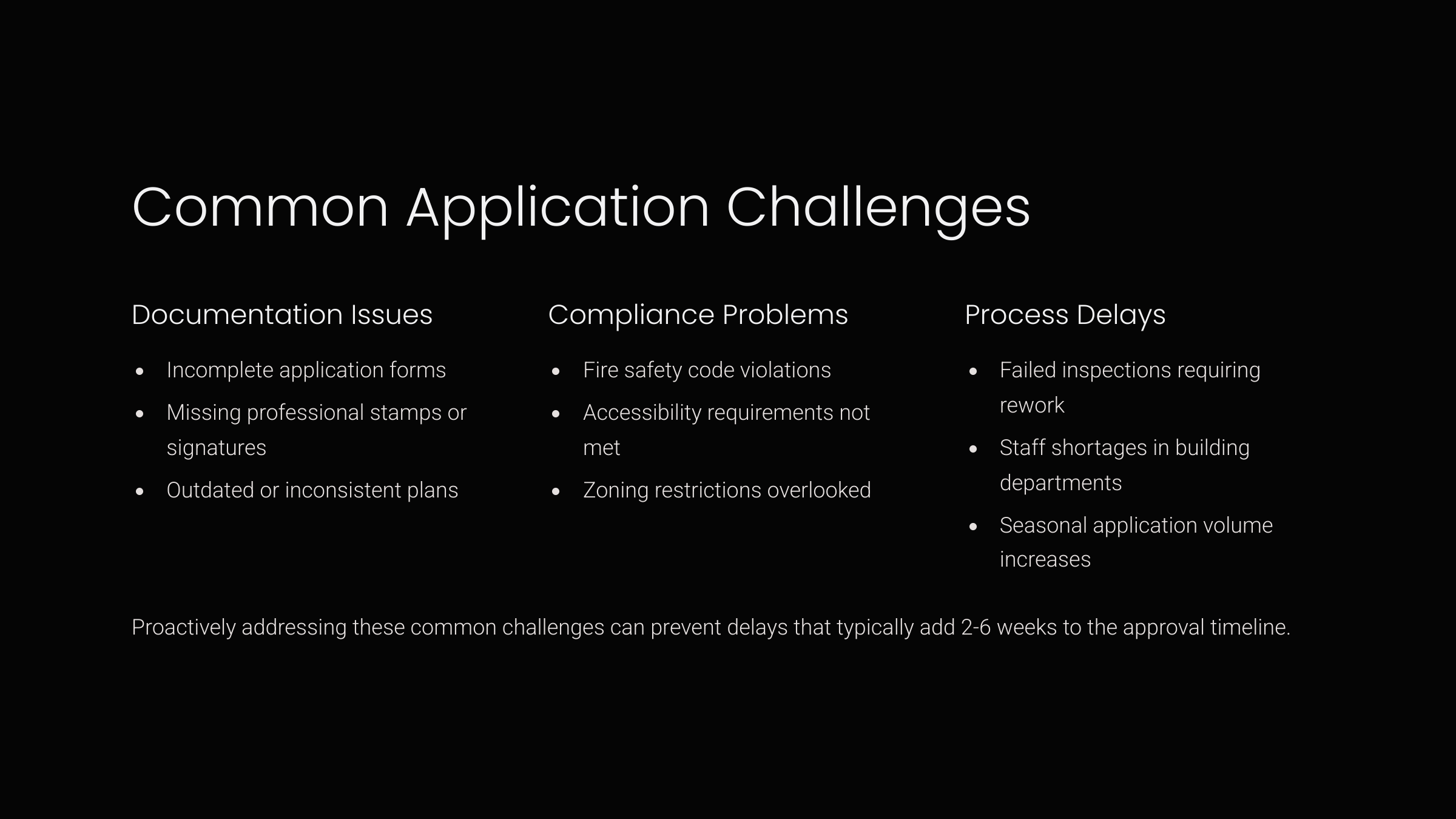
After corrections are made, you'll need to schedule a re-inspection, often with additional fees. Multiple inspections may be required before approval is granted, particularly for complex issues involving multiple systems. To minimize delays, consider hiring specialized consultants for pre-inspections to identify and address potential issues before official inspections.
Can older buildings be "grandfathered in" under previous codes?
Yes, buildings existing before current code adoption may maintain their occupancy if it was legal at the time and hasn't changed since. This concept, known as "grandfathering," allows older buildings to operate under the codes in effect when they were built, rather than requiring immediate updates to meet current standards.
However, this grandfathering provision only applies as long as the use remains unchanged. Any change in use, occupancy, or substantial renovation triggers compliance with current codes. Additionally, some jurisdictions offer amnesty certificates for buildings lacking documentation that existed before certain dates (e.g., March 1, 1986 in Austin, TX).
What's the difference between a temporary and permanent certificate of occupancy?
A temporary certificate of occupancy (TCO) allows occupancy for a limited time period (typically 90 days) while final details are being completed. It's issued when a building is safe to occupy but has minor outstanding items that don't affect safety.
A permanent certificate of occupancy has no expiration date and indicates full compliance with all applicable codes and requirements. TCOs must eventually be converted to permanent COs by completing all outstanding items and passing final inspections.
The primary advantage of a TCO is allowing earlier occupancy and potential revenue generation while finalizing construction details. However, TCOs often involve additional fees and administrative requirements, including tracking expiration dates and ensuring timely completion of outstanding items.
Conclusion and Resources
Certificates of occupancy stand as a fundamental component of property management, serving as the critical link between construction completion and legal occupancy. For property managers, understanding the nuances of CO requirements isn't just about compliance—it's about protecting investments, ensuring tenant safety, and maintaining property value.
As we've explored throughout this guide, navigating the certificate of occupancy process requires attention to detail, thorough preparation, and awareness of local variations in requirements. By implementing the best practices outlined—from researching local requirements to developing relationships with building officials—property managers can streamline the process while minimizing delays and complications.
Remember that while challenges may arise during inspections or when adapting older buildings to new uses, proactive planning and comprehensive documentation create the foundation for successful outcomes. The investment in proper CO compliance pays dividends through reduced liability, enhanced marketability, and uninterrupted operations.
Recommended Resources for Further Learning:
- International Code Council - Provides comprehensive information on building codes and certification programs
- Building Owners and Managers Association (BOMA) - Offers educational resources and networking for commercial property professionals
- National Association of Residential Property Managers - Provides specialized education for residential property managers
- Local building department websites - Most now offer detailed guidance specific to your jurisdiction
- HUD Exchange - Essential resource for managers of affordable housing properties
Take the next step in your professional development by exploring these resources, connecting with local building officials, and implementing systematic approaches to certificate of occupancy management. Your proactive attention to this critical aspect of property management will distinguish your services and protect the properties under your care.


